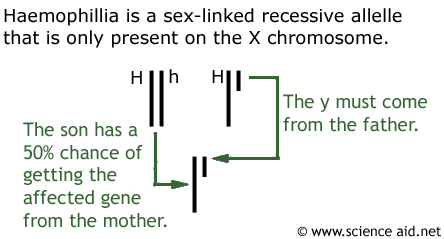Inheritance: Sex Linkage, Dihybrid Inheritance, Epistasis
Edited by Jamie (ScienceAid Editor), Taylor (ScienceAid Editor), SmartyPants
What is a Genotype?
A genotype is the genetic constitution of an organism. It refers to the combination of alleles and genes.
A phenotype is the expression of the genotype and its expression with the environment. For example, there are genes for height, however, if growing up, someone doesn't have good nutrition, they will never grow very tall.
At this level, you should already know about alleles and dominance and recessiveness. Find out here if you don't. We use the term heterozygous when there is a pair of different alleles (Aa) and homozygous when they are the same (BB).
Sex Determination
The sex of someone is not determined by individual genes, but by an entire chromosome pair. In humans, there are 23 pairs of chromosomes. In females, it is normal for the last pair to be XX, while but in males, one of the chromosomes is shorter than the other. Males are said to be XY. See the diagram below
It is also possible to have other chromosome combinations, for example, XXY and XO (only one X chromosome), and these lead to genetic disorders; for more see here. However, it is interesting to note that having the combination XYY has no observable effects, and those with this configuration seem to be normal males.
Monohybrid Inheritance
There are different forms of genes called alleles. These different forms of genes are what create variations amongst living things. There are two types of allele: dominant and recessive. Let's look at an example to understand this.
One type of gene is for eye color. The allele for brown is dominant and thus represented as 'B' (capital letter). The allele for blue eyes is recessive and represented as 'b' (lower case).
The MOTHER has brown eyes and the genotype Bb The FATHER has blue eyes and the genotype bb.
If they have a baby, the baby will get an allele from each parent. You can work out the possible outcomes by representing it in a punnett square.
Two of the outcomes are Bb. This means the baby has a 50% chance of having brown eyes. Even though it has a b (blue eye) allele, it has one B allele, and as this is dominant, the baby will have this characteristic. In order to get blue eyes, the baby must have two recessive blue alleles (bb).
Inheriting Blood Group
Monohybrid inheritance is fairly simple. But now we will look at co-dominance and dihybrid inheritance by studying blood groups and the associated genetics.
You will not always have one recessive and one dominant allele; sometimes, there might be two or more that are co-dominant. Take the example of blood group, where A and B are dominant to O, and A and B are co-dominant. This means that if you have the genotype AO or BO then your blood type will be A or B, but having AB means you have both A and B blood groups, and the only way to have blood group O is to have the genotype OO.
However, there are other markers that affect blood group. One of these is known as the Rhesus factor and is either positive or negative. Positive is dominant and negative is recessive. This means we have two types of genes for the same thing. You can work out the possible outcomes of offspring when these are crossed; this is called: dihybrid inheritance, and it works as follows:
Sex Linkage
As shown in the chromosome diagram above, the male Y chromosome has much less genetic information. This means it doesn't have some genes that the homologous X does. So males only have one copy of a gene and therefore are more likely to be affected by recessive disorders.
If they had a daughter, there would be a 50% chance of HH, and 50% chance of Hh (heterozygous) and a 0 chance of being affected because two affected alleles are needed.
Epistasis
Epistasis is an interaction between two genes where one allele affects the expression of another. This can lead to a graduation of the phenotype. It is best explained by example, so here is a (fictitious) example of rat coloration.
The default color in this example Is to have white fur. If the rat has the dominant gene A, then a pigment is produced to make a brown rat. If the rat has the dominant allele B on top of this, the pigment is modified again to make a black rat. If the rat has the B allele, but not A, then it will remain white because it is a continuum. If you wanted to work out the genetic possibilities, you would use the dihybrid inheritance explained above.
Referencing this Article
If you need to reference this article in your work, you can copy-paste the following depending on your required format:
APA (American Psychological Association)
Inheritance: Sex Linkage, Dihybrid Inheritance, Epistasis. (2017). In ScienceAid. Retrieved Apr 26, 2024, from https://scienceaid.net/biology/genetics/inheritance.html
MLA (Modern Language Association) "Inheritance: Sex Linkage, Dihybrid Inheritance, Epistasis." ScienceAid, scienceaid.net/biology/genetics/inheritance.html Accessed 26 Apr 2024.
Chicago / Turabian ScienceAid.net. "Inheritance: Sex Linkage, Dihybrid Inheritance, Epistasis." Accessed Apr 26, 2024. https://scienceaid.net/biology/genetics/inheritance.html.
If you have problems with any of the steps in this article, please ask a question for more help, or post in the comments section below.
Comments
Article Info
Categories : Genetics
Recent edits by: Taylor (ScienceAid Editor), Jamie (ScienceAid Editor)
















